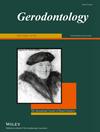Clinically estimated signs of hyposalivation in older adult residents of long-term care
Abstract
Objective
To assess whether the estimation of clinical signs of hyposalivation is applicable in recognising long-term care facility (LTCF) residents with poor oral health, and which individual characteristics are important in that respect.
Background
A common inconvenience among older adults, dry mouth, particularly hyposalivation, can cause many complications, such as greater susceptibility to root caries and oral infections, and it can lead to further deterioration of oral health. However, very little is known about the association of clinically assessed signs of hyposalivation with the oral health status of LTCF residents.
Methods
The study sample comprised 362 individuals (dentate n = 266, edentate n = 96) aged 65 or older. The examinations included a questionnaire and clinical oral examination. Participants were categorised into three groups based on clinically assessed oral dryness: normal salivation (n = 83, 22.9%), lower salivation (n = 182, 50.3%) and dry mouth (n = 97, 26.8%). The association between signs of dry mouth with aspects to oral health was evaluated and further tested with logistic regression analysis.
Results
The signs of oral dryness were observed among females, those with dementia, and those with longer stays in the current facility. Root caries (odds ratio, OR 1.3) and diagnosis of periodontitis (OR 4.1), together with several individual periodontal parameters, as well as having less than ten occluding pairs of natural teeth (OR 3.5) were associated with dry mouth. Edentate participants showed an increased likelihood of having dry mouth with advancing age, and lesions on the lips were associated with dry mouth with OR 3.0.
Conclusion
Clinical estimation of signs of oral dryness can be a useful adjunct in evaluating the oral health status of dentate LTCF residents. Poor oral health was a frequent finding, especially among dentate LTCF residents with signs of dry mouth.

 求助内容:
求助内容: 应助结果提醒方式:
应助结果提醒方式:


